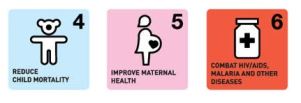In August 2015, reports emerged in the Nigerian press that “Nigeria had attained the Millennium Development Goals”. The article below quoted the Secretary of Programmes in the Office of the Senior Special Assistant to the President on MDGs, Mr. Ogenyi Ochapa, verbatim, with no critical commentary on the validity of his statement, which boldly declared: Nigeria has Attained HIV, Maternal Mortality MDGs ahead of Deadline!
Late in September 2015, almost everyone in the Nigerian health establishment was in New York for the UN General Assembly (UNGA). It was at a side event of the UNGA, at the United Nations headquarters, that the country’s final status report on the implementation of the Millennium Development Goals was released. We have tried to find out if there was a subsequent event in Nigeria to share this report with the Nigerian people, to no avail.

The UNGA meeting in New York where the report of Nigeria’s MDGs status was released. Photo courtesy “NigerianHeadlines”
Other than a few reports on the meeting in September, there has been almost no reportage on the report, or its outcomes. The entire development community has moved on to the new Sustainable Development Goals (SDGs).One reason for this may be that the report itself is almost impossible to find. This most important report that describes the outcomes of a project that Nigeria and all supporting development partners invested billions of Naira is not on the website of the “Office of the Special Assistant to the President on MDGs” as of the last time we accessed it, which was today, 10/11/15.
But it is important that we know if the “Goals” were achieved and what the outcomes of our investments were. So, we got hold of the MDGs End-Point Report and encourage you to read it.
First, let’s remind ourselves on what the Millennium Development Goals were meant to be. In 2000, at the United Nations Millennium Summit, 189 world leaders, including Nigeria’s, adopted the Millennium Declaration to overcome poverty through a set of eight mutually reinforcing interrelated time-bound goals (MDGs) with related targets. One of the stated objectives of the “Goals” was to provide an “accountability framework”. The attractiveness of having goals is that simple statements can be made and communicated on if they were achieved or not. The MDGs were at the forefront of the global development agenda to eradicate poverty by 2015.
In Nigeria, as we do, in 2005 we created the Office of the Senior Special Assistant to the President on the Millennium Development Goals with Directors, Officers and a huge budget to provide guidance, coordination and oversight on the attainment of the MDGs.
There are eight goals, but for the purposes of our platform, lets examine how Nigeria did, from the report of the Office of the Senior Special Assistant, on the 3 health-related goals and associated targets; Goals 4, 5 and 6.
Goal 4: Reduce Child Mortality – Target: Reduce by two-thirds, between 1990 and 2015, the under-five mortality rate. None of the indicators for this target; under-five mortality rate, infant mortality rate and the proportion of one year-old children immunized against measles were met in Nigeria.
Goal 5: Improve Maternal Health – Target: Reduce by three-quarters, between 1990 and 2015, the maternal mortality ratio. The first indicator is on maternal mortality ratio, which the report says that Nigeria has met – from a baseline figure of 1000 deaths per 100,000 live births in 1990 to its end-point status of 243 per 100,000 live births in 2014.
However this is contradicted by data from the Demographic and Health Survey done in Nigeria in 2013 and carried out by the National Population Commission and partners, which reported that the maternal mortality ratio in 2013 was 576 deaths per 100,000 births, an insignificant difference from the 2008 finding of 545 deaths per 100,000 births.
Draw your own conclusions. None of the other indicators; proportion of births attended by skilled health personnel, unmet need for family planning, and antenatal care coverage were met.
Goal 6: Combat HIV and AIDS, malaria and other diseases – Target: Have halted, by 2015, and begun to reverse the spread of HIV and AIDS. None of the nine indicators relating to HIV, TB and Malaria were met and on TB specifically, incident rates are actually increasing.
In summary, of the 16 indicators relating to three Millennium Development Goals relating to health, 15 were not met and only one was met. The one that was met, relating to maternal mortality is contradicted by data from a report considered to be the industry standard for that indicator, also commissioned by the same government.
Granted, the MDGs were ambitious, and granted there has been some progress on many of the indicators, but there is really nothing to celebrate considering the funds invested by the Nigerian Government and development partners on behalf of the Nigerian people.
Before going full steam into committing funds to the new Sustainable Development Goals, it would be prudent to do a critical review on the approach taken by Nigeria. This is especially important as the government reaches conclusions on whether setting up a mini-parastatal as in the “Office of the Senior Special Assistant to the President on the Millennium Development Goals” that was constructing buildings and boreholes across the country was the right approach rather than investing in the public institutions with a mandate to carry out these functions.
With a new government in place in Nigeria, just at the time the new SDGs have been agreed, there is no better time to ask these questions.








2 Comments